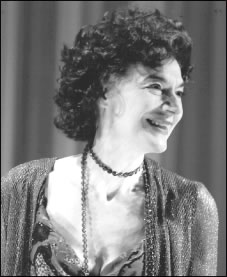BY JERRY TALLMER
Gifted interpreter of Albee and O’Neill joins their ranks
I first met Marian Seldes in a sleeping bag. She was in the sleeping bag. I was out in the seats, there to write a critique of the play and performance. The theater was the Orpheum (still around, at Second Ave. and 7th St.). The play was J.P. Donleavy’s “The Ginger Man.” The year was 1963. November, 1963. The stars were Patrick O’Neal and Margaret Phillips — but the Obie Award went to the young woman in the sleeping bag.
Forty-seven years later, Marian Seldes will be honored with a Tony Award for Lifetime Achievement in the Theater (when The Tony Awards take place on Sunday, June 13).
During a recent conversation, she glanced around her living room — one whole side of which is buried in boxes upon boxes of theater programs, scripts, magazine articles, photographs, newspaper clippings, and other evidences of that lifetime.
“Do you remember?” she said. “ ‘The Ginger Man’ opened the day Kennedy was shot. I loved that play, and it was an Irish play.”
With a nod of the head toward all those boxes: “Articles in newspapers I don’t want to lose. I know that newspapers get thrown out with the fish, but still…my father wrote for newspapers…”
He did indeed. He was Gilbert Seldes, and — among many other accomplishments — before Marian was born he had put comic strips, vaudeville, jazz, radio broadcasting, etc., on the map of culture with a pioneering 1924 book called “The Seven Lively Arts.”
Over and above too many Tony nominations and Obies to count, this will be her second actual Tony Award. The first, in 1967, was for her performance in Edward Albee’s Pulitzer-winning “A Delicate Balance.”
She and Albee are a Broadway/Off-Broadway parlay over all these years, and she has never been finer than as one-third of the dramatic stand-ins of that playwright’s (adoptive) mother in the dazzling 1994 “Three Tall Women” — or as a loony, smiling death dealer opposite Brian Murray in Albee’s 2001 “The Play About the Baby.”
The lesson is: She gets better and better. A critic might say — as praise — she also gets looser and looser.
In point of fact, her stage career (quite apart from movies and tons of radio and TV) has been divided almost evenly between Broadway and Off-Broadway. According to printouts from Internet databases, 26 Broadway shows vs. 25 Off-Broadway shows between her 1947 baptism (a small part in Katharine Cornell’s “Medea”) and now.
“Looking at these lists,” she says as she does just that, “It occurs to me that the titles have got less and less interesting. Words like ‘This’ and ‘Ah’ and ‘Uh.’ ”
Well, Marian, says a theatergoing journalist, the creator of a lot of those terse titles just happens to be Mr. Samuel Beckett.
“Yes, I know — ‘Eh,’” says the actress — who only a few seasons ago appeared at the Century Center on East 15th Street in a Beckett/Albee double bill.
As she continues to study those two lists: “I’m utterly fascinated,” she says, “but I shouldn’t be.”
Why not, Marian?
“Because this is the past.”
Come now. Remember what Faulkner said when he got the Nobel Prize: ‘The past isn’t dead. It isn’t even past.’
“Oh, I love that!” she exclaims with a laugh. Her broken shoulder — from a fall at home a few weeks ago — doesn’t make it easy to laugh. “You know,” she says, “I never thought of either of us as getting old.”
It was Guthrie McClintic, Katharine Cornell’s director husband — Gilbert Seldes had done a New Yorker magazine profile of Cornell — who suggested that Marian go to the Neighborhood Playhouse to learn to be an actress under the tutelage of the great Sanford Meisner.
“I’d done some summer stock, but I don’t think anybody took that seriously at the time.” In 1947 (still in her teens), she found herself in Buffalo — as a living, breathing actress in “Medea” — “and thought that if I have to die now, I’ll still be so happy.”
It was a tiny, non-speaking role as a servant girl — “in black makeup; they wouldn’t do that now. I also understudied the women of the chorus. John Gielgud directed it and played Jason.”
A month or two later, she was in her first speaking part on Broadway as the murderer’s sister — Raskolnikov’s sister — in “Crime and Punishment.” The Raskolnikov was John Gielgud. The two female stars were cinema’s great Lillian Gish and the Dolly Haas (Mrs. Al Hirschfeld) who would become a lifelong dear friend.
“Everything connects in my career,” Seldes says. “I grew up in an apartment in a [since demolished] nine-story building at 125 East 57th Street. The great scene and costume and lighting designer Robert Edmond Jones lived in the same building.
“I loved his book, ‘The Dramatic Imagination,’ and still do love it. He felt no shame at loving all actors. ‘I want the actors to hold me,’ he said. I’m going to use that at the Tony nominees’ luncheon.”
Marian’s first venture Off-Broadway, even before ‘The Ginger Man,’ was in four roles of Eugene O’Neill’s “The Long Voyage Home” — under the guidance of Paul Shyre, the gifted director who would also reintroduce Sean O’Casey to the United States of America.
“How did I get into that? I don’t know.” As if talking to a producer/director/playwright: “ ‘What made you choose me? Or what made you not choose me?’
“It’s all good or bad fortune. I’ve auditioned for almost everything I’ve ever done. It’s so much better to go in and try rather than to sit across a desk and be me — and I would still rather do it [audition] today.”
Sometimes you don’t even have to do that. “Edward [Albee — who else?] and [producer] Richard Barr had a little theater on 27th Street. I was in a play there, and when I came off, Richard Barr said: ‘Don’t cut your hair. I have a part for you.’ ”
The part was her Tony-winning Julia in “A Delicate Balance.”
Her eye again runs down the lists of her Broadway and Off-Broadway roles, 1947 to now.
“My dream was to do a lot of classical plays. People think I’ve done a lot of classics, but I haven’t, but I can get by.”
Does anybody speak of troupers any more? Seldes will always be famous among theater people for never having missed one single performance as Myra Bruhl in “Deathtrap” — the Ira Levin thriller that took place on Broadway 1,793 times from February 1978 to June 1982.
“I was John Wood’s wife, so to speak. But I had lots of husbands [besides two real ones, Julian Claman and Garson Kanin, both now dead] because I stayed in the play so long.
“But I didn’t miss [any class in] high school either. I try to show up when I say I will,” says the wounded-shoulder Lifetime Achiever. It’s a bad joke, Ms. Tony Awardee, but break a leg.


















